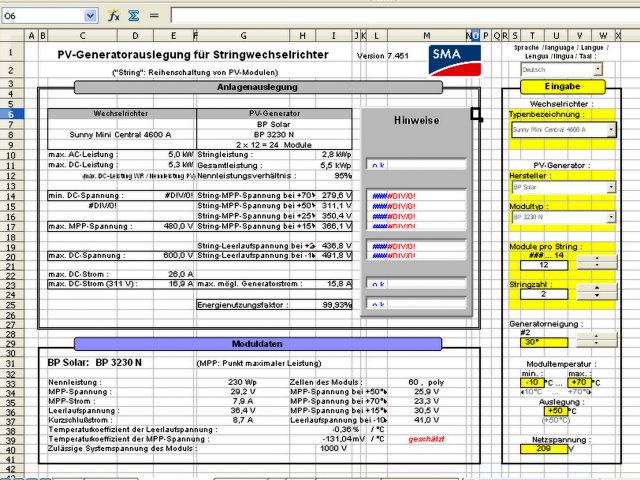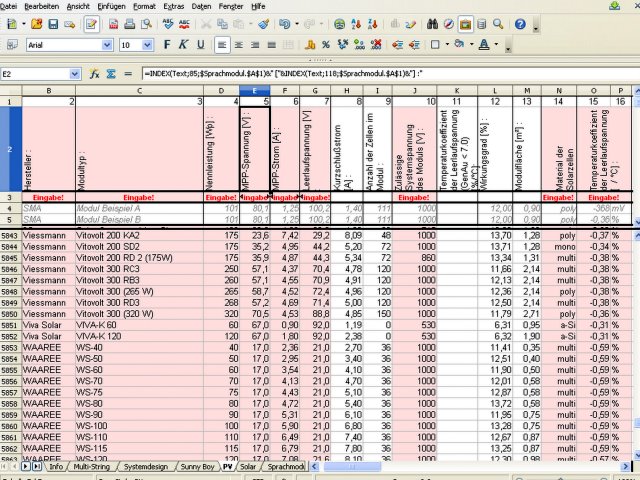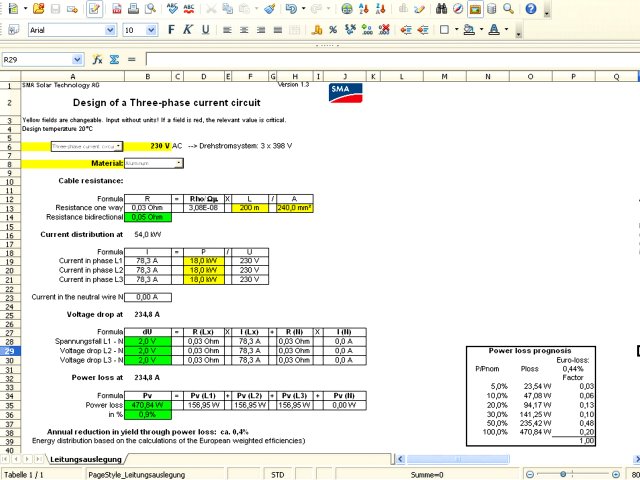|
|
 |
|
 |
pk
 POWER & EFFICIENCY POWER & EFFICIENCY
If you know the nominal peak power or rated power of your system, you don`t need to know the efficiency, except to calculate the area of the modules. This is why:The nominal peak power is the power rating or given by the manufacurer of the module or system. It is the power output of the modules ( s ) measured at1000W/m² solar irradiance ( and a module temperature of 25°C and a solar spectrum corresponding to an air mass of 1.5 ). This means that if your modules were 100% efficiency, you would need 1 m² to get a system with a peak power of 1 kW. These conditions are known as Standard Test Conditions ( STC )Since the modules are NOT 100% efficient you need a bigger area. If you have 10% efficient modules you need 10 m² to have a 1 kWp system. The module efficiency at Standard Test Conditions we will call eff nom.In other words, if Ppk is the nominal peak power and A the area of the module ( s ), we have
Ppk =A*effnom
the actual power depends on the irradiance G and the real module efficiency eff which is a function of irradiance and module temperature Tm ( andsometimes more things which we will forget about here ) So you have the actual power:
P = G/1000* A*eff ( G,Tm ) = G/1000*A*effnom * effrel ( G, Tm )
where we have written the actual efficiency as the product of the nominal efficiency effnom and the relative efficiency effrel ( G, Tm )Combining Eq. 1 and 2 you get:
P = G/1000*Ppk * effrel ( G, Tm )
Therefore, if you know the relative and the peak power, you don`t need to know the nominal efficiency or the area. BUT: if you want to know either the nominal efficiency OR the area, you will need know the other of the two parameters. If you know the nominal efficiency and the peak power, you can calculate the area using Eq. 1:
A = Ppk /effnom
Energy rating method
The method used in PVGIS to estimate the actual PV output from a given type of PV module is based on a mathematical formula that takes into account the first three of the effects mentioned above. This means that the method can only be used on PV technologies that do not depend strongly on the solar spectrum, and do not show effects of long term exposure to irradiation or high temperatures. Therefore we do not at the moment try to calculate the output of amorphous silicon which are more dependent on these two effects.The formula for estimating the relative efficiency used in Eq.2 looks this:
effrel ( G, Tm ) = In ( G`) + k2 In(G`)2 + k3Tm
+k 4 Tm In (G`) + k 5Tm In (G`)2 + k6 Tm2
where G`= G/1000 The coefficients k 1 to k 6 depend on the type of PV technology used. These coefficients have been found by comparisons with measured values for each of the different technologies. The module temperature T m is calculated from the ambient temperature by the following formula:
T m = T amb + K T G
This formula shows how the modules are heated up by the solar radiation. It is a very simple formula that doesn`t take into account cooling effects such as wind. If your system is in a very windy area, this will reduce the temperature of the modules and this will help increase the efficiency a bit. The coefficient k T depends on the type of mounting used for the PV system. In general, a building-integrated system will be hotter than a free-standing rack-mounted system becaiuse the air cannot circulate freely around the back modules and cool the modules. In PVGIS we have used the following values:
kT = 0.035°C/ ( W/m² ) for free-standing systems, based on measurements done at our laboratory
kT = 0.05°C/ ( W/m²) for building-integrated systems, based on values taken from literature
Excel sheet for easy design of PV-generators.


Excel table for easy dimensioning of PV-generators.

|
|
|
|



